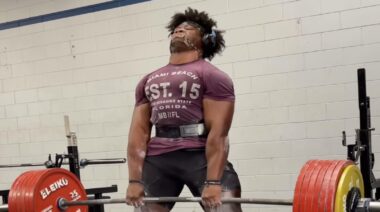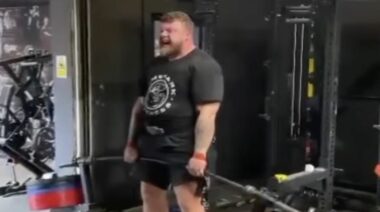The deadlift lies at the root of all primitive movement patterns. When our ancestors faced immovable boulders or had to heave saber-toothed cats from the ground to over their shoulders to carry their prize home to the tribal feast, the hip hinge pattern was critical.
“Grok spear you, then Grok deadlift your carcass.”
No matter who you are or what your goal, strength will always set you free. The big three movements – push, pull, and press – are the most basic and foundational movement patterns that determine overall performance capacities in many, if not all sports.
For beginners, simply deadlifting more and heavier will develop strength and success. But as strength improves, that gray area between frequent deadlifting and overtaxing the pattern and your nervous system becomes distinct. Stronger athletes need to balance training volumes and intensities. This makes supplemental exercises that much more important to not only increase foundational lifts, but also to stave off injury and overtraining.
These five movements are imperative for troubleshooting the weak points in your training to maximize your results.
1. Meadows’ Row
It seems the posterior chain is a key factor in the execution of any lift. Since we are an upright species that constantly fights gravity, back strength is pivotal to positional stability, which can influence the hips and spine while in the hinge position. Inadequate back strength, in this case weakness in the latissimus dorsi, can result in excessive thoracic flexion, lumbar flexion, and protraction of the shoulder blades. All of this can cause missed lifts and injury.
“[A] strength improves, that gray area between frequent deadlifting and overtaxing the pattern and your nervous system becomes distinct.”
Use this row variation not only to build lat strength, but work the hinge movement in a unilateral (single-sided) pulling pattern to correct any asymmetries and imbalances in the hips and back.
Try this:
- 3-4 sets of 8-10 reps
- Perform 1-2 times per week
- Perform after main lifts
2. Pull Up or Lat Pulldown
Few exercises can improve lat development better than the pull up. No matter who you are, pull ups should be a staple in your posterior chain training program, especially since lat development and muscular tension are key to a successful deadlift.
Try this:
- Do 100-200 pull ups per week for a month straight, doing as many sets as necessary.
- If you have issues doing high volume pull ups, do as many as you can until failure on one day, and then hit the remainder of the reps on the lat pulldown working in sets of 10 on the other day.
- Record the total number of sets and reps done for every workout, and try to decrease the amount of sets needed to reach 100.
- When I say a pull up, I mean a strict pull up. Kipping and butterfly pull ups can wreak havoc on your shoulder girdle, as well as give your body a mechanical advantage, which negates the necessity for the lats to grow stronger.
3. Power Shrug
The trapezius is a primary stabilizer of the scapular region and spine, making this large muscle critical for postural stability throughout the deadlift. This gem of an exercise will not only improve your scapular stability, but can promote greater grip and positional strength off the floor and in the lockout.
“[B]ack strength is pivotal to positional stability, which can influence the hips and spine while in the hinge position.”
Try this:
- 3-4 sets of 8-12 reps
- Perform 1-2 times per week
- Perform after main lifts
- Vary your grip widths and methods (wide, narrow, mixed grip, double-overhand grip)
4. Partial Romanian Deadlifts
The hamstrings and glutes are primary movers in the deadlift, yet often people spend too much time working the full range of motion instead of isolating the large posterior chain muscles groups. The benefit of using an isolation approach to specifically target the hamstrings and glutes is that you minimize the forces on your lower back, spine, and connective tissues, and therefore target the primary movers for your pulling lifts.
Try this:
- 3-4 sets of 8-12 controlled reps at 50-60% of your 1RM deadlift.
- Partial repetition training is helpful for keeping tension on the active muscles, promoting local fatigue, muscle breakdown, and lactic acids build up, all of which are necessary for muscle growth.
- Perform these one time per week. Due to the nature of this exercise, marked soreness may also occur.
- Keep loads lighter than normal, and work on deep stretches of the hamstrings
5. Single Leg Deadlift
This unilateral exercise will highlight any asymmetries or imbalances in your hinge patterning, improving your hip mobility and preventing potential injury. Hip mobility and stability are the first steps in accessing sound pulling technique. With this exercise, you will be able to determine if your hips are tracking similarly throughout the movement.
With these two variations, you can build unilateral strength and stability. The kettlebell is great to fine-tune hip mobility and balance, while the barbell landmine option allows for greater loading due to a decreased demand for balance. Try both out and see which works best for you. Just remember the goal is to build strong muscle through quality repetitions at moderate to light loads.
Try this:
- 2-3 sets of 10-15 reps
- Perform 1-2 times week
- Perform after main lifts or as a movement facilitation exercise prior to training
Supplementing the Deadlift
Now that you have these five supplemental exercises in your wheelhouse, you can start to isolate the specific components of your deadlift that may need extra emphasis. Just remember, supplemental exercises are exactly what they are called. They do not replace the main lift and are not effective standing alone. You will need to deadlift and deadlift again, but not necessarily always heavier.
Check out these related articles:
- What I Learned From Deadlifting 500 Pounds
- How to Do the Seated Cable Row for a Bigger Back
- 15 Practical Strategies to Increase Your Deadlift Max
- What’s New On Breaking Muscle Today
Photo 1 courtesy of Shutterstock.






